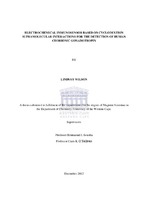Electrochemical immunosensor based on cyclodextrin supramolecular interactions for the detection of human chorionic gonadotropin
Abstract
Glucose oxidase (GOx) and horseradish peroxidase (HRP) are important enzymes for the development of amperometric enzyme linked immunosensors. The selectivity of each enzyme towards its analyte deepens its importance in determining the sensitivity of the resultant immunosensor. In designing immunosensors that have customized transducer surfaces, the incorporation with FAD and iron based enzymes ensures that electron kinetics remains optimal for electrochemical measurement. Various different immobilization strategies are used to produce response signals directly proportional to the concentration of analyte with minimal interferences. The combination of self-assembled monolayers and
supramolecular chemistry affords stability and simplicity in immunosensor design. In this work, two electrochemical strategies for the detection of human chorionic gonadotropin(hCG) is presented. This involves the modification of a gold surface with a thiolated β-cyclodextrin epichlorohydrin polymer (βCDPSH) to form a supramolecular inclusion complex with ferrocene (Fc)-functionalised carboxymethyl cellulose polymer (CMC). Cyclic voltammetry indicated that ferrocene is in close proximity to the electrode surface due to the supramolecular complex formed with βCDPSH. Furthermore, strategy (a) for the detection of hCG used α-antihCG labelled (HRP) as reporter conjugate. Strategy (b) maintained the CMC bifunctionalised with Fc and recognition antibody for hCG hormone. However, the
system was functionalised with a HRP enzyme and detection is done by using GOx reporter conjugates for in situ production of hydrogen peroxide. The reduction of H2O2 was used for the amperometric detection of hCG by applying a potential of 200 mV. The sensitivity and limit of detection of both strategies were calculated from calibration plots. For strategy (a) the LOD was found to be 3.7283 ng/mL corresponding to 33.56 mIU/mL and a sensitivity of 0.0914 nA ng-1 mL-1. The corresponding values for strategy (b) are 700 pg/mL (6.3 mIU/mL) and 0.94 nA ng-1 mL-1.

